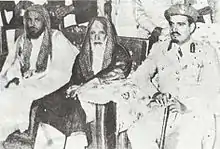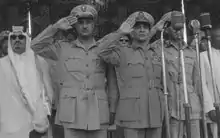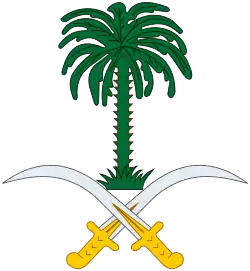Mishaal bin Abdulaziz Al Saud
Mishaal bin Abdulaziz Al Saud (Arabic: مشعل بن عبد العزيز آل سعود, romanized: Misha`al bin `Abd al `Azīz as Saʻūd; 5 September 1926 – 3 May 2017) was a Saudi Arabian politician and businessman. A member of the House of Saud, he held different cabinet posts in the 1950s and was the chairman of the Allegiance Council from 2007 to 2017.
| Mishaal bin Abdulaziz Al Saud | |||||
|---|---|---|---|---|---|
 Prince Mishaal (first from the right) | |||||
| Chairman of the Allegiance Council | |||||
| Tenure | 2007–2017 | ||||
Monarch | |||||
| Governor of Makkah Province | |||||
| Tenure | 1963–1971 | ||||
Appointed by | |||||
| Predecessor | Abdullah bin Saud bin Abdulaziz | ||||
| Successor | Fawwaz bin Abdulaziz | ||||
| Minister of Defense | |||||
| Tenure | 1951–1953 | ||||
Monarch | |||||
Prime Minister | King Saud (1953) | ||||
| Predecessor | Mansour bin Abdulaziz | ||||
| Successor | Fahd bin Saud | ||||
| Born | 5 September 1926 Riyadh, Kingdom of Hejaz and Nejd | ||||
| Died | 3 May 2017 (aged 90) Riyadh, Saudi Arabia | ||||
| |||||
| House | Saud | ||||
| Father | King Abdulaziz | ||||
| Mother | Shahida | ||||
| Occupation | Government official • businessman | ||||
Early life
Prince Mishaal was born on 5 September 1926.[1][2] He was the thirteenth son of King Abdulaziz.[3]
He was the full brother of Prince Mansour, Prince Mutaib and Princess Qumash who died on 26 September 2011.[4] Their mother was an Armenian woman, Shahida, (died 1938),[5] who reportedly was the favorite wife of King Abdulaziz.[6][7] She was of Christian origin.[8]
Career

Prince Mishaal served as the minister of defense from 12 May 1951 to 1953.[9][10] He replaced his full brother Prince Mansour as minister of defense when he died in 1951.[11] Until that date, Prince Mishaal served as deputy minister of defense. When Prince Mishaal became minister, his younger full brother Prince Mutaib was appointed his deputy.[6][12] As minister of defense, Prince Mishaal became one of the most affluent princes in the Al Saud family.[12] He bought state land for very cheap prices and yielded extraordinary profits.[12] But because of his lack of education and experience, Prince Mishaal let the ministry remain completely unorganized. He leaned heavily on advice and recommendation from foreign counsel.[12] He wielded significant influence in King Abdulaziz's government.[12] Because of Mishaal's considerable power, King Abdulaziz countered his influence by appointing Abdullah bin Faisal as minister of health and interior.[12]
At the same time, King Abdulaziz established the ministry of air force under Prince Mishaal to prevent flight-related matters from going under Prince Talal, the minister of communication.[12] Since Mishaal and Talal could not agree, Saudi Arabia was to have two airline fleets.[12] But in April 1955, Prince Talal resigned from the office, and the ministry of communication was merged with the ministry of finance.[12] In May 1955, King Saud created a renewed modern National Guard which was led by Saud's son Prince Khalid who replaced a commoner.[12] This move weakened Prince Mishaal due to the fact that he had often used the old National Guard's resources.[12]
Prince Mishaal's tenure as minister of defense ended in 1956 when he was dismissed by King Saud because of his alleged pro-Nasserist views and corruption claims.[13] Prince Fahd bin Saud, a son of King Saud, replaced him in the post.[13] In 1957 Prince Mishaal was made a member of the council of the minister as an advisor to King Saud.[14]
Mishaal and his full-brother Mutaib returned to favour in 1963 under regent and later King Faisal who entrusted them a key governorship and deputy governorship, respectively. Specifically, Mishaal served as governor of Makkah Province[3] from 1963 to 1971. In 1969 Prince Mishaal was also made the head of the Saudi Tourism Authority.[15] Both Mishaal and Mutaib resigned from their posts in 1971 for reasons that are not entirely clear.[6]
Prince Mishaal was appointed chairman of the Allegiance Council on 10 December 2007.[16]
Succession to the throne
Mishaal bin Abdulaziz protested more than once that he should have been crown prince since he served as both a governor and a minister and was older than some of his brothers. It is argued that he was immediately excluded from the competition for the title of crown prince by the Sudairi brothers.[3] One of the reasons for his exclusion was his low-level relations with tribes.[17]
Influence
Mishaal bin Abdulaziz was impartial in family politics, although he was known to incline towards King Abdallah or be one of King Abdullah's close allies.[3] His neutral stance made him the perfect choice to be the chairman of the Allegiance Council. This role was considered to be a significant position, giving him influence in the decision-making process in regard to succession.[18]
Business activities
Mishaal bin Abdulaziz was a leading businessman, with substantial investments in real estate, insurance, electrical utilities, oil trading and cement manufacture.[19] He was chairman of the board of Yanbu Cement company, established in 1976.[20]
He founded Al Shoula Group in 1970,[21][22] which is a major investor in real estate developments throughout the Middle East partnering with such investors as Dubai's Emaar Group, Kuwait's Bayt Al Mal Investment Company, and the Al Rajhi family's Tameer Group. Al Shoula's wholly owned subsidiary, Dhahran Global, is active in broad areas of the petroleum and petrochemical industry including pipeline development, oil and gas production, oilfield services and international product trading.[23] The CEO of Al Shoula Group was his son Prince Abdulaziz[23] who was appointed to the post in the late 1990s.[22]
Prince Mishaal was one of the founders of the Dar Al Maal Al Islami Trust which was initiated by Mohammed bin Faisal Al Saud, King Faisal's son, in 1981.[24] He was also the owner of Shola Shopping Center in Riyadh and the Mishaal International company.
Charity
In the early 1970s Prince Mishaal allocated land in Mecca for the foundation of charities which would assist Palestinian families whose children had been killed during the operations against Israel.[25]
Controversy
In 2013 Faisal Almhairat, a Jordanian businessman and Prince Mishaal's former business partner, alleged that Prince Mishaal and his son, Prince Abdulaziz, involved in money laundering activity for various rich individuals and groups, including Hizbollah, and opened a case in London.[26][27]
Personal life
Mishaal bin Abdulaziz was a supporter of the traditional camel racing and horse racing, and had valuable racing camels and horses. Each year, he patronized camel races in the kingdom. He also dealt with traditional falconry.[28]
One of his wives was Noura bint Fawwaz, a granddaughter of Nuri Al Shalaan, and they divorced.[29] Prince Mishaal's son, Mohammed bin Mishaal, died at age 58 in February 2005.[30] His other sons include Prince Faisal, Prince Mansour and Prince Bandar.[31] Prince Faisal is the son-in-law of former Crown Prince Sultan, and his spouse is Princess Latifa.[32] Abdulaziz bin Fahd married Al Anoud bint Faisal in December 2010.[33]
In October 2009 Mishaal bin Abdulaziz was rushed to hospital in Geneva, apparently having suffered a stroke.[18] Then, he returned to Saudi Arabia from unspecified medical treatment in Beirut in December 2009.[6] Mishaal died on 3 May 2017 at the age of 90 according to the Saudi Press Agency.[1][19]
Ancestry
| Ancestors of Mishaal bin Abdulaziz Al Saud[34] | |||||||||||||||||||||||||||||||||||||||||||||||||||||||||||||||||||||||||||||||||||||||||||||||||||||||||||||||||||||||||||||||||||||||||||||||||||||||||||||||||||||||||||||||||||||||||||||||||||||||||||||||||||||||||||||||||||||||||||||||||||||||||||||||||||||||||||||||||||||||||||||||||||||||||||||||||||||||||||||||||||||||||||||||||||||||||||||||||||||||||||||||||||||||||||||||||||||||||||||||||||||||||||||||||||||||||||||||||||||||||||||||||||||||||||||||||||
|---|---|---|---|---|---|---|---|---|---|---|---|---|---|---|---|---|---|---|---|---|---|---|---|---|---|---|---|---|---|---|---|---|---|---|---|---|---|---|---|---|---|---|---|---|---|---|---|---|---|---|---|---|---|---|---|---|---|---|---|---|---|---|---|---|---|---|---|---|---|---|---|---|---|---|---|---|---|---|---|---|---|---|---|---|---|---|---|---|---|---|---|---|---|---|---|---|---|---|---|---|---|---|---|---|---|---|---|---|---|---|---|---|---|---|---|---|---|---|---|---|---|---|---|---|---|---|---|---|---|---|---|---|---|---|---|---|---|---|---|---|---|---|---|---|---|---|---|---|---|---|---|---|---|---|---|---|---|---|---|---|---|---|---|---|---|---|---|---|---|---|---|---|---|---|---|---|---|---|---|---|---|---|---|---|---|---|---|---|---|---|---|---|---|---|---|---|---|---|---|---|---|---|---|---|---|---|---|---|---|---|---|---|---|---|---|---|---|---|---|---|---|---|---|---|---|---|---|---|---|---|---|---|---|---|---|---|---|---|---|---|---|---|---|---|---|---|---|---|---|---|---|---|---|---|---|---|---|---|---|---|---|---|---|---|---|---|---|---|---|---|---|---|---|---|---|---|---|---|---|---|---|---|---|---|---|---|---|---|---|---|---|---|---|---|---|---|---|---|---|---|---|---|---|---|---|---|---|---|---|---|---|---|---|---|---|---|---|---|---|---|---|---|---|---|---|---|---|---|---|---|---|---|---|---|---|---|---|---|---|---|---|---|---|---|---|---|---|---|---|---|---|---|---|---|---|---|---|---|---|---|---|---|---|---|---|---|---|---|---|---|---|---|---|---|---|---|---|---|---|---|---|---|---|---|---|---|---|---|---|---|---|---|---|---|---|---|---|---|---|---|---|---|---|---|---|---|---|---|---|---|---|---|---|---|---|---|---|---|---|---|---|---|---|---|---|---|---|---|---|---|---|---|---|---|---|---|---|---|---|---|---|---|---|---|---|---|---|---|---|---|---|---|---|---|---|---|---|---|---|---|---|---|---|---|---|---|---|
| |||||||||||||||||||||||||||||||||||||||||||||||||||||||||||||||||||||||||||||||||||||||||||||||||||||||||||||||||||||||||||||||||||||||||||||||||||||||||||||||||||||||||||||||||||||||||||||||||||||||||||||||||||||||||||||||||||||||||||||||||||||||||||||||||||||||||||||||||||||||||||||||||||||||||||||||||||||||||||||||||||||||||||||||||||||||||||||||||||||||||||||||||||||||||||||||||||||||||||||||||||||||||||||||||||||||||||||||||||||||||||||||||||||||||||||||||||
References
- Mohammad Sulami (4 May 2017). "Prince Mishal bin Abdulaziz passes away at 90". Arab News. Retrieved 4 May 2017.
- "Saudi Arabian royal succession". APS Diplomat News Service. 14 November 2011.
- Nabil Mouline (April–June 2012). "Power and generational transition in Saudi Arabia". Critique Internationale. 46: 1–22. doi:10.3917/crii.046.0125.
- "Custodian of the Two Holy Mosques performs funeral prayer on the soul of Princess Gumash bint Abdulaziz". Riyadh Municipality. 27 September 2011. Retrieved 12 August 2012.
- "Biography of Shahida". Datarabia. Retrieved 10 August 2012.
- Joseph A. Kechichian (2001). Succession in Saudi Arabia. New York City: Palgrave. ISBN 9780312238803.
- Simon Henderson (August 2009). "After King Abdullah" (PDF). Washington Institute. Archived from the original (Policy Paper) on 21 October 2012. Retrieved 28 July 2012.
- Leslie McLoughlin (1993). Ibn Saud: Founder of A Kingdom. New York: Palgrave Macmillan. p. 239. ISBN 978-1-349-22578-1.
- "Land Forces History". Royal Saudi Land Forces (RSLF). Archived from the original on 31 July 2017. Retrieved 12 May 2012.
- Talal Kapoor (8 June 2012). "Nayif's Departure: Spring Cleaning in The Royal Court". Datarabia. Retrieved 10 June 2012.
- "Royal Saudi Land Forces History". Global Security. Retrieved 21 July 2013.
- Steffen Hertog (2011). Princes Brokers and Bureaucrats. Ithaca, NY; London: Cornell University Press. p. 46. ISBN 978-0-8014-5753-1.
- Nadav Safran (2018). Saudi Arabia: The Ceaseless Quest for Security. Ithaca, NY; London: Cornell University Press. p. 105. ISBN 9780801494840.
- George T. Fitzgerald (1983). Government administration in the kingdom of Saudi Arabia (Master of Public Administration thesis). California State University, San Bernardino.
- "The death of Prince Mishaal bin Abdulaziz". Sayidaty (in Arabic). 3 May 2017. Retrieved 15 May 2021.
- "Prince Mishaal to head Allegiance Commission: Saudi launches royal succession committee". Al Arabiya. 10 December 2007. Archived from the original on 14 December 2013. Retrieved 10 November 2012.
- Khalid Saud Alhumaidi (2016). Regime stability in Saudi Arabia: The role of the population composition represented by the tribes (MA thesis). University of South Dakota. ProQuest 1882302961.
- Talal Kapoor (7 July 2010). "Briefing: Prince Mish'al's Health Condition". Datarabia. Retrieved 11 May 2012.
- "Saudi King Salman's brother Prince Mishaal dies". Gulf Business. 4 May 2017. Retrieved 4 May 2017.
- "History". Yanbu Cement Company. Retrieved 29 May 2012.
- Mehran Kamrava; Gerd Nonneman; Anastasia Nosova; Marc Valeri (3 November 2016). "Ruling Families and Business Elites in the Gulf Monarchies: Ever Closer?" (Research paper). Chatham House. Retrieved 15 October 2020.
- Nimah Mazaheri (2013). "The Saudi monarchy and economic familism in an era of business environment reforms". Business and Politics. 15 (3): 310. doi:10.1515/bap-2012-0039. S2CID 231796126.
- "Al Shoula Group". Dhahran Global Company. Retrieved 29 May 2012.
- Mohammed bin Faisal Al Saud (2014). "The Well of Influence". In Emmy Abdul Alim (ed.). Global Leaders in Islamic Finance: Industry Milestones and Reflections. Singapore: Wiley. p. 56. doi:10.1002/9781118638804.ch3. ISBN 978-1-118-46524-0.
- Joseph Mann (2014). "Saudi-Palestinian Relations During the Run-Up to and the Aftermath of Black September". Terrorism and Political Violence. 26 (4): 716. doi:10.1080/09546553.2013.773899. S2CID 145710333.
- Michael Peel; Jane Croft; Caroline Binham (16 May 2013). "Saudi princes deny laundering claim". Financial Times. Retrieved 13 August 2020.
- Estelle Shirbon (21 May 2013). "Claim Saudi princes laundered Hezbollah money "fanciful": Lawyer". Reuters. London. Retrieved 15 October 2020.
- Mischal ibn Abd al-Aziz
- William Lancaster (1981). The Rwala Bedouin Today. Cambridge: Cambridge University Press. p. 86. ISBN 978-0-521-28275-8.
- "Prince Mohammed bin Misha'al dies". Bahrain News Agency. 4 February 2005. ProQuest 468204676. Retrieved 15 September 2020.
- "Prince Mishaal leaves for Beirut". Saudi Press Agency. 18 August 2005. ProQuest 468632234. Retrieved 15 September 2020.
- "ابناء الامير سلطان بالترتيب" (in Arabic). Almrsal. 26 May 2019. Retrieved 14 May 2021.
- "الأمير عبد العزيز بن فهد يحتفل بزواجه من كريمة الأمير فيصل بن مشعل". Al Riyadh (in Arabic). 23 December 2010. Retrieved 6 June 2012.
- "Family Tree of Mish'al bin Abd al-Aziz bin Abd al-Rahman Al Saud". Retrieved 8 May 2017.
External links
- Mishaal bin Abdulaziz Official website
 Media related to Mishaal bin Abdulaziz Al Saud at Wikimedia Commons
Media related to Mishaal bin Abdulaziz Al Saud at Wikimedia Commons

